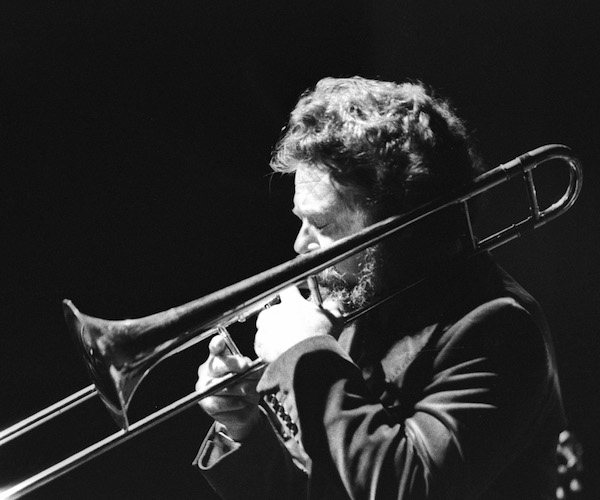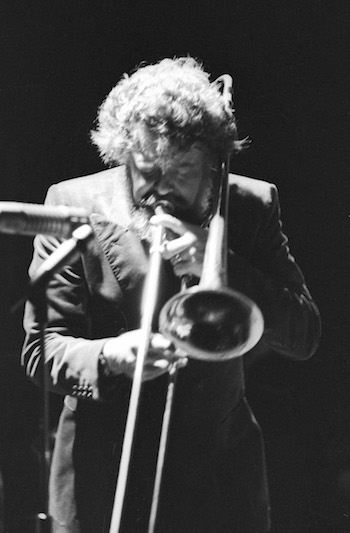Jazz Remembrance: Roswell Rudd — Avant-garde Trombonist Extraordinaire
The late Roswell Rudd tried every sound a trombone could make, all of his efforts marked with a natural musicality.

Roswell Rudd in Boston during the early ’70s. Photo: Michael Ullman.
By Michael Ullman
Ornette Coleman, a man of remarkable wisdom, used to advise musicians to play what their instruments wanted them to play. He thought that the tenor saxophone wanted to play blues. He might, however, have been addressing a whole generation of bebop trombonists who, following in the giant footsteps of J.J. Johnson, tried to make their instrument sound like Charlie Parker’s alto. The difficulty was obvious; Johnson called the trombone “a beastly, horrid instrument.” But to the great avant-garde trombonist Roswell Rudd, who died on the 22nd of prostate cancer at the age of 82, it was also a great conversationalist.
Rudd recorded dozens of sessions as a leader but, given his long-standing relationships with musicians such as Archie Shepp, Steve Lacy, John Tchicai, Carla Bley, and Cecil Taylor, he should also be celebrated as an inspired collaborator, an expert at contributing to group improvisations. He played what his instrument wanted him to, using the slide to register brash glissandi, growls, sarcastic comments or, as in his serene turn on Cecil Taylor’s “Things Ain’t What They Used to Be” (Candid), sauntering in with a solo so relaxed he seems to be sight-seeing. There’s a moment in Archie Shepp’s “One for the Trane” (Live at the Donaueschingen Festival in which Shepp slows down what had been a frantic solo. Rudd seems to swagger drunkenly around him, playing in broad strokes. A few minutes later he is playing brash long tones, as if he were making an important announcement. Rudd could bump along a bass line, mumble gratuitously, or almost shriek. He could also play with a submerged anxious murmur, huffing and puffing like an employee coming in late to work. Rudd tried every sound a trombone could make, all of his efforts marked with a natural musicality that reflected his mastery of blues and ballads. To my ears, he always sounded engaging as well as engaged, eager to joke as well as to please.
Rudd was raised on Dixieland. Born in Connecticut, Rudd talked about the jam sessions his father, a sometime drummer, hosted in his home. It’s arguable New Orleans trombonist Kid Ory’s 1922 tune “Ory’s Creole Trombone” was as important to the young Rudd as anything he heard in bebop. In the introduction, Ory slides up and down, sounding as if he were trying to impersonate a marching band. The first time most of us heard (and saw) Rudd came in 1958. During the opening credits for the film Jazz on a Summer’s Day, famous because of singer Anita O’Day’s classy performance, we see a group of youngster careening around town in a convertible playing Dixieland. Rudd was the soloist.
His first recordings (in 1955 and 1957) were made with a Yale-based group of cheerful musical reactionaries: they called themselves Eli’s Chosen Six, and they were ‘chosen’ to revive twenties hits such as “Muskrat Ramble” and “That Ja-Da Strain.” The years that followed must have been eventful, though they are relatively undocumented, given that his next recordings (in 1961) were with the likes of Cecil Taylor, Archie Shepp, and Steve Lacy. The Cecil Taylor-Buell Neidlinger set is mostly a tribute to Duke Ellington. On “Jumpin’ Punkins,” Rudd enters muted, emitting a hint of a growl. On the third take of these Ellingtonian blues he is more outgoing, playing a series of sonic rips and downward slides before retiring…prematurely, in my estimation. He comes to life again in the following group improvisation. This is neo-Dixie.
In 1962, Rudd joined soprano saxophonist Steve Lacy for a series of quartet recordings of mostly Monk material. Lacy was a precise, thoughtful player, also with a background in Dixieland. On School Days, the quartet plays Monk’s “Ba-Lue Bolivar Ba-Lues-Are.” Via a series of broken phrases, Rudd proves himself (as he would over and over) a wonderfully inventive blues player. Their “Pannonica” calls on Rudd to accompany Lacy’s mostly fragmented statement of the theme with a grumbling, often staccato, commentary: they duet together for the rest of the tune. This is a wonderful recording that laid out new paths for the trombone. With alto saxophonist John Tchicai, Rudd started up the New York Art Quartet, which first recorded in 1964. By then he had garnered his first awards: he won the down beat international critics’ poll as the new star on the trombone. Critics were taking note.

Roswell Rudd in Boston during the early ’70s. Photo: Michael Ullman.
1964 was a heady year for the new jazz. Coltrane was at his peak, of course, Taylor was finally making an impact, and Coleman was just getting started. For Rudd, there were numerous appearances with the New York Art Quartet, which seemed to model itself more after Coleman than Trane. The trombonist also recorded with the Jazz Composer’s Orchestra; on August 10 made a seminal recording, Four for Trane under Shepp’s leadership. For that session, Rudd arranged a complicated version of Coltrane’s “Naima” (spelled on my Impulse lp “Niema,” with an elegant introduction by the four horns (Shepp, Rudd, Alan Shorter, and John Tchicai). Careful riffing and long tones followed. Rudd would also perform in the next few years with Carla Bley and the Jazz Composer’s Orchestra: he’s on the albums The Jazz Composer’s Orchestra, Escalator Over the Hill, and on Charlie Haden’s Liberation Music Orchestra. He had become the favorite trombonist of the jazz avant-garde.
It wasn’t until 1973 that he got to lead his own big band recording, the now out-of-print Numatik Swing Band. It’s a good-humoured set that begins with a drum solo by Beaver Harris, followed by “Breathahoward,” which features an astonishingly agile, bluesy solo by by tuba player Howard Johnson. Rudd stars on the walking blues “Circulation”; avant-garde music perhaps, but the kind you can dance to. He features trumpeter Enrico Rava on “Aerosphere,” and singer Sheila Jordan on “Lullaby for Greg.” Later, Rudd would be part of the recording The Enrico Rava Quartet(ECM). The collaboration with Sheila Jordan was even more fruitful. In 1974, Rudd and Jordan recorded Flexible Flyer (Arista), a remarkably joyous recording. It begins dramatically, with Rudd, solo, playing low long tones before Jordan comes in at an impossibly slow tempo to sing “What Are You Doing for the Rest of Your Life.” Both Jordan and Rudd sing on “Suh Blah Blah.” Jordan is an extraordinary vocal improviser: the piece seems to be fading out and then she returns to scat, magnificently, over the rhythm section. Then the piece is transformed into a swinging four/four when pianist Hod O’Brien reasserts himself. Rudd follows with one of his most vibrant solos. Flexible Flyer offers a varied set, including the light-hearted “Waltzing in the Sagebrush” and the humor and swing of Suh Blah. This is a band I heard both in Boston and in a small club in New York City: half the audience seemed to be made up of other musicians. Rudd and Jordan were even better live than on recordings.
Later Rudd taught at Bard College and at the Univerity of Maine. He continued to record up to the end of his life. His generosity and kindness as a musician are legendary. He even expanded his range as the years went by, recording the music of Mali (Malicool and Blue Mongol) with a group of Mongolian musicians. For me, nothing will replace his early recordings, such as Everywhere, in which he pays beautiful tribute to the older trombonist Bill Harris. To riff on one of his album titles, I would say Rudd was one of those who kept his heart right (and his lip in shape).
Michael Ullman studied classical clarinet and was educated at Harvard, the University of Chicago, and the U. of Michigan, from which he received a PhD in English. The author or co-author of two books on jazz, he has written on jazz and classical music for The Atlantic Monthly, The New Republic, High Fidelity, Stereophile, The Boston Phoenix, The Boston Globe, and other venues. His articles on Dickens, Joyce, Kipling, and others have appeared in academic journals. For over 20 years, he has written a bi-monthly jazz column for Fanfare Magazine, for which he also reviews classical music. At Tufts University, he teaches mostly modernist writers in the English Department and jazz and blues history in the Music Department. He plays piano badly.
